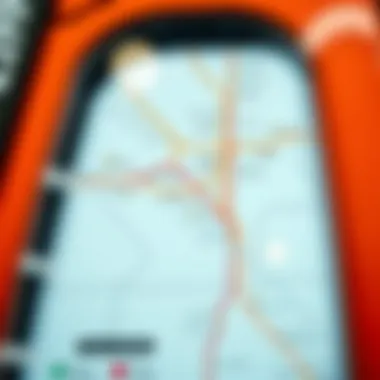Understanding Dubai Metro Operational Hours for Efficient Travel


Intro
The Dubai Metro is not just a mode of transport; it’s a lifeline that connects the bustling city with its vast opportunities. Understanding the operational hours of the Metro is crucial for both new residents and seasoned commuters alike. With layers of complexities woven into Dubai’s structured hustle and bustle, knowing when the train comes and goes can significantly enhance your travel experience.
The Metro operates extensively throughout the week, but as any regular would attest, there are variations from day to day. Weekdays, weekends, and public holidays all play a role in the rhythm of the service, ensuring that the needs of both the daily commutes and the visting tourists are met. This not only aids commuters in finding their way during the busy rush hours but also helps in planning leisurely trips around the city.
So, whether you're a homebuyer scouting for properties close to Metro stations or an expatriate figuring out your daily routs, this guide will serve as your compass in navigating the intricate metro system of Dubai.
Understanding the Dubai Metro System
The Dubai Metro is not just another public transport option; it represents a significant advancement in urban mobility within this bustling city. Established to alleviate traffic congestion and provide efficient transportation, it stands as a key element in Dubai’s urban plan. With increasing population figures, the metro has swiftly become the backbone of the public transport system, connecting diverse communities and enabling smooth travel across the metropolis.
Overview of the Metro Network
At its core, the Dubai Metro consists of two main lines—the Red Line and the Green Line. Together, they serve a vast network, stretching over 75 kilometers and comprising more than 50 stations. This network provides access to key areas such as Dubai International Airport, shopping centers like the Mall of the Emirates, and various residential neighborhoods.
- Red Line: This line primarily runs along Sheikh Zayed Road, connecting the city from north to south.
- Green Line: A noteworthy feature that serves the older parts of the city, this line connects areas rich in culture and history.
The metro is fully automated and is equipped with state-of-the-art technology, enhancing the user experience. The convenience of having multiple stations in proximity to major landmarks makes it a vital resource for both residents and visitors alike.
Importance to Urban Mobility
The significance of the Dubai Metro extends beyond just providing a mode of transportation. It plays a crucial role in promoting sustainable travel and reducing pollution levels in the city. By encouraging the use of public transport, the metro contributes to less reliance on cars, thus cutting down on traffic jams, which can be as common as the palm trees lining the streets. Furthermore, its operational efficiency further supports urban mobility efforts—services run regularly, offering commuters a reliable option to fit their busy schedules.
"With the steady increase in daily commuters, the metro's scheduled service helps maintain a rhythm in the city's transportation flow, thereby enhancing overall productivity."
Additionally, the Dubai Metro accommodates a diverse demographic. Be it expatriates, tourists, or daily commuters, it offers a cost-effective solution for traveling across the city. This aspect becomes particularly relevant for investors and homeowners who seek properties in areas with convenient access to public transport.
Moreover, the metro's accessibility features, including facilities for those with reduced mobility, showcase an inclusive approach to urban transport. This attention to detail resonates well with Dubai's vision of becoming a global city that prioritizes innovation and inclusivity.
In summary, the understanding of the Dubai Metro system is central to appreciating its role in urban mobility. By providing efficient and sustainable transport solutions, it not only shapes daily commuting patterns but also enriches the fabric of urban life in Dubai. It’s a testament to the city's commitment towards creating a smarter urban environment.
Standard Operating Hours
These hours serve as a lifeline for many who rely on public transportation for work, leisure, or exploration. They directly influence travel plans, whether you're a resident moving between neighborhoods or a tourist eager to experience the city. More importantly, acknowledging the nuances of the service schedule empowers users to optimize their journeys, ensuring they avoid unnecessary delays and fully harness what the metro has to offer.
Weekday Service Schedule


The weekday service schedule of the Dubai Metro plays a significant role in catering to the high volume of commuters. Typically, the metro operates from 5:00 AM to midnight. During peak hours—roughly between 7:00 AM and 9:00 AM, and 5:00 PM to 8:00 PM—the frequency of trains increases to accommodate the larger influx of passengers. This can mean trains arriving as close as every 2 to 3 minutes.
It's essential to note that the exact timing may vary slightly based on the line and specific station. Keeping an eye on the timetable can save a lot of waiting time.
Weekend Service Schedule
When it comes to weekends, the metro offers a different cadence. For those planning rail travel on Fridays and Saturdays, the operational hours extend from 10:00 AM to midnight. This shift allows for a more relaxed atmosphere, catering to leisure travelers and families taking trips into the city. The waiting time between trains might also be longer during these days, so patience is vital if you’re setting out to explore.
Public Holidays and Special Events
Public holidays bring a unique twist to the Dubai Metro schedule. On these days, especially significant festivities like Eid or the National Day, the metro often extends its operating hours. This reflects the need to accommodate increased travel demands during festive occasions when people flock to malls, parks, and celebrations.
A good way to stay informed about any changes is to check official announcements, which can often be found on the RTA website. Additionally, local news sources may also provide valuable updates regarding any planned service modifications.
"Staying informed about Dubai Metro's operational hours can enhance your travel experience, making your journey smoother and more enjoyable."
In summary, knowing the standard operating hours presents an edge for anyone navigating Dubai’s dynamic landscape. From weekday rush hours to the leisurely pace of weekends and the festive shifts during public holidays, understanding these schedules can ensure you never miss a beat.
Factors Influencing Operating Hours
Demand Fluctuations
- Peak Travel Times: During peak hours, particularly in the mornings from 7 AM to 9 AM and evenings from 5 PM to 8 PM, the metro sees an influx of commuters. To accommodate this rise, operational hours may be extended during weekdays, ensuring reliable service for the working population.
- Weekends and Holidays: In contrast, weekends and holidays generally draw fewer commuters. However, these periods can also see spikes in tourist traffic, especially when major events or festivals are taking place. Hence, the operational hours may adjust, perhaps offering extended service on weekends or reducing hours during quieter times.
"Understanding demand patterns is crucial for optimizing public transport schedules, ensuring efficiency and satisfaction among its users."
Operational Constraints
In addition to demand fluctuations, operational constraints also shape the operating hours of the Dubai Metro. These constraints can arise from various sources, including infrastructure limitations, maintenance needs, and safety regulations.
- Routine Maintenance: Regular maintenance activities are vital for ensuring safety and efficiency. This often involves closing certain lines or sections of the metro during off-peak hours or overnight, subsequently affecting operational hours. As a result, commuters may need to plan their travel around these scheduled downtimes.
- Regulatory Compliance: The metro must adhere to strict guidelines set forth by local transportation authorities. These regulations can dictate minimum service hours, safety protocols, and capacity management, again influencing the overall timetable.
- Seasonal Variations: Seasonal activities, such as Eid or Dubai Shopping Festival, can prompt adjustments in both service frequency and hours. This responsiveness to local events reflects the metro's commitment to serve both the community and visitors effectively.
The interplay of demand and operational constraints provides a clearer picture of the flexible nature of the Dubai Metro's operating hours. For commuters, understanding these elements aids in better preparing for their journeys through one of the world's most dynamic urban landscapes.
Navigating the Metro Timetable
Creating a personalized travel experience in Dubai heavily revolves around understanding its metro timetable. Given that the metro operates as a pivotal cog in the urban transportation machine, it becomes essential for every commuter—be it a local resident or a foreigner—to navigate this schedule effectively. In essence, grasping the matrix of operational hours allows individuals to plan their movements with pinpoint precision, balancing time management and convenience. Moreover, the integration of digital solutions into the navigation of the metro system presents an array of benefits that cater to various user needs.
Accessing Timetable Information


To utilize the Dubai Metro system effectively, one must first gain access to timetable information that clearly outlines service hours across different days. Luckily, this isn't rocket science. Several resources exist to simplify this task. Commuters can find the official timetable on the Roads and Transport Authority (RTA) website or via reputable travel blogs focused on the Dubai transportation landscape. Important details, such as first train and last train timings, can ensure you’re not left stranded.
- The standard weekday operations typically start from 5 AM until midnight, while weekends extend the service slightly later, from 5 AM to 1 AM on Thursdays and Fridays.
- A cursory glance at public holiday hours is also prudent, since they may differ from standard operational times.
"Accessing accurate timetable information is not just about planning your travel; it's about ensuring your time in the city is spent wisely."
Utilizing Mobile Applications
In an age where smartphones are nearly an appendage to the human body, leveraging mobile applications becomes indispensable. The RTA’s dedicated app is specifically designed to ease the navigation of metro timings and routes. This application features automatable alerts for shifts in service hours, unexpected delays, or upcoming maintenance. For users who thrive on real-time updates, this is a boon.
- Key Features of the RTA App:
- Interactive maps that delineate various metro routes.
- Live updates regarding service interruptions.
- A user-friendly interface that even the least tech-savvy can navigate.
- Options to purchase tickets directly through the app, eliminating lines at ticket counters.
Often overlooked, utilizing such mobile applications can provide a seamless experience that enhances the commuter's journey from point A to point B, ensuring they maximize their time in Dubai without the hassle of unpredictability.
Impact on Daily Commuters
Peak vs Off-Peak Travel
During peak times, the Dubai Metro tends to buzz with commuters, especially early in the morning and late afternoon. Many residents rush to grab their spot to avoid long waits during these flashy hours. For instance, weekdays from 7 AM to 9 AM and 5 PM to 7 PM are generally the busiest, as many residents rely on the metro to reach their workplaces. The frequency of trains increases during these windows, which is a blessing for those in a hurry, but it is wise for commuters to brace themselves for a cramped space.
On the flip side, off-peak hours—mid-mornings and early afternoons—offer a stark contrast. The trains operate with fewer passengers, allowing for more comfortable travel. Commuters traveling during off-peak times might find themselves facing less wait time and more legroom. In fact, the operational hours encourage flexibility; those who can adjust their routines might opt for 10 AM to 4 PM travel to skip the crowds entirely.
Time Management Strategies
To take full advantage of the operational hours, it's beneficial for commuters to strategize their time effectively. Here are some tips:
- Plan Ahead: Knowing the metro timetable can help avoid unpleasant surprises. The information is readily available on the RTA website or through mobile apps.
- Utilize Real-Time Tracking: Using tracking apps not only allows you to see how many stops are left but also alerts you of any delays or train intervals.
- Off-Peak Commuting: If time permits, traveling at mid-day can enhance the experience, offering a slice of tranquility amidst the city's hustle.
- Combine Routes: Sometimes, taking a transfer instead of sticking to a single line can save precious minutes, particularly if your destination is near a transfer point.
- Optimize Your Schedule: If your employer allows for flexible hours, starting earlier or later in the day often leads to less stress while traveling.
In short, knowing the ins and outs of the Dubai Metro’s operating hours opens doors to better travel experiences. It allows commuters to craft their own travel strategies, ensuring they hit the ground running rather than playing catch-up.
Tourist Considerations
Understanding how the Dubai Metro serves tourists is crucial for anyone visiting this bustling city. The metro system not only eases your travel but also enriches your overall experience in Dubai. For foreigners, the metro acts as a valuable asset, facilitating easy access to numerous landmark attractions while bypassing the notorious traffic that can be expected in urban areas. This section sheds light on a tourist's perspective of navigating through Dubai's metro network.
Metro as a Tourist Resource
The Dubai Metro stands out as a core resource for tourists, thanks to its extensive network that connects vital locations. From the iconic Burj Khalifa to the historic Dubai Museum, the system provides a fast and affordable way to explore the city. The clean, air-conditioned trains and well-maintained stations create a pleasant travel atmosphere. Here are a few essential resources travelers can tap into:


- Navigation: Each metro line is color-coded, simplifying the process of mapping out journeys.
- Information: Announcements in multiple languages, including English and Arabic, ensure that tourists are kept well-informed.
- Interconnectivity: The metro intertwines with various bus routes and tram systems, making it easier to reach more remote destinations.
Utilizing the metro decreases reliance on taxis, which can eat into your vacation budget. Moreover, you can bypass the hustle of street traffic, making it a smooth ride from point A to point B.
Travel Tips for Visitors
Tourists looking to maximize their metro experience can benefit from some simple yet effective tips. Here’s a short list to steer you in the right direction:
- Buy a NOL Card: This rechargeable smart card is crucial for easy access to the metro, as well as buses and water taxis. It makes traveling more efficient without the fuss of cash.
- Plan Ahead: Research the metro's operating hours, especially if you’re planning late-night trips. It’s best to know when the last train departs.
- Avoid Rush Hour: Peak hours could leave you jostling for space. Try to travel during off-peak times for a more comfortable ride.
- Follow Etiquette: Remember to give priority seating to those in need, including the elderly and pregnant women, as part of the local courtesy.
"Embracing the metro allows visitors to experience the urban cloth of Dubai seamlessly, making each stop an opportunity for discovery."
With these considerations in mind, tourists can navigate the metro system not just as passengers, but as explorers ready to unveil everything Dubai has to offer.
Future Developments and Changes
Potential Extensions to Service
In recent years, there has been a growing call for the expansion of metro services to cover a broader area, taking into account both residential and commercial needs of a rapidly increasing populace. Reasons for these extensions can be manifold:
- Increased Population Density: As Dubai continues to grow, more residents are flocking to the outskirts of the city. Expanding the metro network could better serve these new communities, making commute quicker and more convenient.
- Tourism Boost: With the influx of tourists, enhancing metro reach could provide easier access to major attractions, including the Expo 2020 site and surrounding areas that have seen development. Visitors can travel without the need for costly taxi rides or car rentals.
- Economic Development: New metro lines could catalyze economic growth in underdeveloped areas of the city, attracting businesses and creating jobs.
Currently, proposals and feasibility studies are underway to identify key locations where extensions could be beneficial. Such measures are essential not only for commuter convenience but also to maintain the Dubai Metro’s reputation as one of the most advanced public transportation systems.
Long-Term Viability of Operating Hours
Long-term planning for the operational hours of the metro is crucial. A significant aspect to consider is how existing schedules align with the evolving needs of residents and tourists alike.
- Adapting to User Needs: As more individuals work non-traditional hours, it becomes important for metro services to potentially adjust their operating hours. For instance, accommodating shift workers or late-night events could foster a more inclusive transit environment.
- Sustainability Initiatives: Future revisions may also align with governmental goals for sustainability, promoting off-peak travel with incentives or discounts. This would not only smoothen the daily commute but also contribute to reducing carbon emissions.
To ensure the metro’s longevity, a combination of data-driven analysis to predict demand fluctuations, alongside user feedback, will be essential. Operators need to remain agile, updating service hours when necessary while also carefully considering operational efficiencies.
"A transport system that evolves with its users is more likely to succeed in the long term."
Concluding Thoughts
Summarizing Key Points
- Weekday vs. Weekend Service: Understanding the variation between weekday and weekend service is key for planning travel. During weekdays, the operating hours generally extend longer in response to commuter needs, while they shift slightly on weekends, catering to leisure and tourism.
- Public Holidays and Special Events: Recognizing that service hours can be further adjusted during holidays provides an essential insight for anyone planning travel during peak times or festivities. Such adjustments can markedly affect travel plans and overall transportation efficiency.
- Impact on Commuters and Tourists: The importance of the Metro's operating hours cannot be overstated, as they directly impact work-life balance for residents and travel convenience for tourists.
A thorough comprehension of the Metro's operational hours not only aids in better planning but also enhances the overall experience of moving around in a vibrant city like Dubai.
Final Recommendations for Metro Users
- Leverage Technology: Use mobile applications that provide real-time updates on service hours and track trains. This ensures you won't be caught off guard by service interruptions or adjustments.
- Plan Ahead for Holidays: Take into account public holidays and special events when arranging your travel. Knowing the altered service hours can save you from unexpected delays.
- Be Mindful of Peak Hours: Try to travel during off-peak hours if possible. This not only aids in avoiding crowded rush hours but also makes for a smoother journey.
- Stay Informed: Regularly check the Dubai Metro website or local news outlets for any sudden changes to operating hours or major service announcements.







